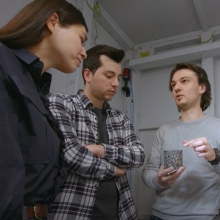Every engineer and especially current engineering students, understand the role and impact Computer has had in the history of science and technology. The whole field of Mechanics (simply put, study of motion of matter) was also hugely beneficial with computers. During my bachelor studies, I realized through hands-on experiences how specific computational applications solve some important problems. Computational Mechanics covers a whole range of applications – from designing the best paper plane you could to the rockets that is soon about to take Man to Mars.
Why COMMAS for me?
In Mechanical and Automotive Engineering, any product or design needs to be safe for the user. One way to ensure this is to create simulations. In my Bachelor studies, I was part of a Student Racing team and we had to use Computer Aided Engineering softwares to validate our design.
One can push buttons in these softwares and get graphs. But to really know what happens behind a simulation, one has to look at what is happening behind the screen. I used to work on Crash simulations of the vehicle we were building and the simulation were based on lot of physical assumptions and idealizations. My goal was just to know – why are we doing it like this ? And I found the answer exactly in what COMMAS students learn.
What do I learn in COMMAS?
In COMMAS, one gets to learn the nature of how materials and structure behave and why they behave like that. A lot of these courses needs the help of computers to solve the humongous equations that are required and the data that accompany it.
The curriculum of COMMAS has the possibility to get updated every year depending on recent trends. The program offers a lot of electives that I feel are very interesting and state-of-the-art. One also has the possibility to do some courses out of the program (with some formal approval). With the advent of new techniques like Data Analytics and Artificial Intelligence, I also learn about how to use these in conjunction with conventional computational Mechanics. The SimTech webpage will give some exciting insights in this new emerging domain.
Offering cutting-edge Research
I always believe the progress of an educational institution depends not on how much grants it has, but on the research mission. Like the University’s mission – Intelligent systems for a Sustainable society, the researchers and professors at COMMAS produce significant work in specialized domains.
For me of particular interest is in the work being done at Institutes like Institute of Applied Mechanics and Institute of Structural Mechanics. Through initiatives like the Cluster of Excellences, specific problems are being deeply analysed and solved in the areas of Materials and Structures. Usually, these research groups offer student positions and later continue with them to pursue a PhD.
What is so special about COMMAS?
COMMAS is an unique course by the area of its focus. As the name suggests, the program deals more with Materials and Structures. This amount of focus sets up a foundation for the student’s career.
In terms of preparing students for further career in research, I needed to talk with someone who did COMMAS and now pursuing research. So, I talked with Mr. Elten Polukhov, COMMAS Course Director and also a PhD Student. He is also a past COMMAS graduate and he shared few of his insights that makes COMMAS stand out: “Every year, COMMAS organizes an event called Summer School for its students, which brings to stage some of well renowned researchers in the field of Computational Mechanics. This really motivates students to excel. Also, initiatives like Stuttgart Centre for Simulation Sciences build a sustainable aim for the field.”
For me, the city of Stuttgart also motivated me to take up the program. The city is home to world-renowned automakers and engineering companies that excel and pioneer the field of Computational Mechanics.
Last but not least - the People
I wanted to meet new people better than me, people from different cultures. With COMMAS being a well-sought out program, it offers the best people to study and work with. The program has an acceptance rate of 5% from around 750 applications which ensures that the quality of its incoming graduates is always better.
I get to meet people with different interests, better spirits in a challenging environment. Most of my classmates come from Mechanical and Civil Engineering background. But there are also quite a few people from domains such as Aerospace Engineering, Material Science, Mechatronics etc, who bring in an interesting mix to the discussions.
Some final tips from me!
If you are a future applicant to COMMAS reading this blog, then I have few tips for you to be successful in your process. Few of these were passed on from my seniors to me, so I hope this will help you too.
- For application: Make sure your documents are well checked and satisfy the requirements. Also be sure to check and then provide other technical documents.
- After application: Start brushing your basics! COMMAS is a tough course and it demands excellent foundations in Mechanics and Mathematics.
- During studies: Keep an open mind. COMMAS will not be a piece of cake, with lot of assignments and exercises going on for each lecture. So be well planned and organized according to your schedule.
Ram Dhiwakar Seetharaman
Comments
January 9, 2023 4:36
Pavan
Nice :)
Comment on this article
Your email address will not be published.



